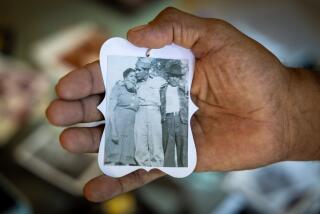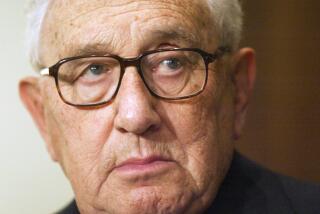Che’s legacy looms larger than ever
- Share via
LA HIGUERA, BOLIVIA — It was a long fight, but the Cubans have finally conquered this forlorn Andean hamlet, four decades after Ernesto “Che” Guevara was executed in the adobe schoolhouse here.
Cuban physicians provide healthcare, Cuban educators oversee literacy classes, and the Cuban-donated library features Che-as-superhero comic books. A monumental bust of the beret-topped revolutionary who helped Fidel Castro seize power in Cuba dominates the central plaza.
“Great men like Che never die,” said Ubanis Ramirez, one of hundreds of Cuban doctors and teachers imported by leftist Bolivian President Evo Morales, whose office features a likeness of Guevara crafted from coca leaves. “His lesson is with us always.”
Sympathizers from across the globe will make the trek to this remote corner of Bolivia this week to mark the 40th anniversary of the capture and killing of Guevara, militant leftist icon and global brand, the radical chic face adorning countless T-shirts, posters, album covers and tattoos.
Today, the ideological legacy of this peripatetic militant may loom larger than ever in Latin America, abetted by the election of a “Pink Tide” of leftist governments from Nicaragua to Argentina. Socialism is in, the Cubans are on the march, and Che is the defiant embodiment of it all.
To his critics, Guevara was a trigger-happy megalomaniac whose bloody example led thousands to their deaths in futile uprisings that only hardened military repression from Guatemala to Chile.
But to the legions of devotees who subscribe to his personality cult, Guevara is forever the doomed idealist, the poetry- loving guerrillero and “most complete human being of our age,” in the words of Jean-Paul Sartre.
“Our side is moving forward, and we don’t have to go to the mountains and fight like Che did anymore,” said Osvaldo Peredo, who heads Bolivia’s Che Guevara Foundation and lost two brothers in guerrilla wars, one fighting alongside Che.
Cuban doctors and petro- dollars from Hugo Chavez’s Venezuela are the new arsenal in a nonviolent insurrection that Guevara, committed to armed struggle, could never have envisioned.
“Finally, Che’s dream is coming true,” said former Mexican Foreign Minister Jorge Casteneda, a Guevara biographer who casts Che more as wayward fanatic than inspired visionary. “Cuba’s export of revolution is finally succeeding in many countries in Latin America, thanks to Chavez and his oil.”
A legendary guerrilla leader in the Cuban Revolution that ousted dictator Fulgencio Batista in 1959, Guevara stumbled in his 1960s struggles. Virtually exiled from Cuba after differing with Castro and Cuba’s Soviet patrons, he suffered an ignominious defeat alongside anti-U.S. rebels in Congo before meeting his demise in a secluded Bolivian canyon at the end of a quixotic 11-month campaign.
But, 40 years later, Guevara has scored big in the contested battleground of memory, emerging as a kind of secular saint, freeze-framed at age 39 between the Summer of Love and the abyss of 1968. Hollywood sees box-office cachet in Che: Director Steven Soderbergh is filming a new biopic starring Che look-alike Benicio Del Toro.
“Today Che is associated in the collective conscience with values -- his ethics, his principles, his willingness to lose his life for an ideal,” biographer Pacho O’Donnell wrote recently in the Argentine weekly Veintitres.
Guevara, a physician with no formal military training, was also something else, critics say: prolific executioner, dogmatic totalitarian and co-designer of the Cuban police state and indoctrination apparatus.
His detractors contend that his short life may appear to his admirers more James Dean than Chairman Mao, but his politics were more Comrade Stalin than Mahatma Gandhi.
“What’s left is a kind of idealistic, romantic aura,” said Jorge Lanata, an Argentine journalist who has written about Guevara. “It’s more culture than political.”
Guevara, keen to ignite “many Vietnams,” chose impoverished Bolivia in part because of its proximity to his Argentine homeland, where he hoped to jump-start an insurgency. Today’s Cuban volunteers in Bolivia live by the credo “Seremos como El Che! (We will be like Che!)” the communist island’s signature chant.
“All my life we communist pioneers pledged to be like Che,” said Jose Valledaris, 45, a Cuban engineer who was watering shrubbery inside the Guevara mausoleum at a former military airstrip in nearby Vallegrande, where the bodies of Guevara and six fellow combatants were dumped in a ditch 40 years ago and buried. “Now I’m here, in the footsteps of Che.”
A renovated laundry shack behind the nearby Senor de Malta Hospital has become one of the most venerated stops on the “Che tour.” It was here that the triumphant Bolivian military displayed Guevara’s body as a war trophy atop a concrete washtub, and Freddy Alborta photographed the Christ-like figure of the pale, posthumous Che, his eyes wide open -- an iconic image distributed worldwide. Che pilgrims scrawl memorial graffiti on every available cranny.
“Man is nothing more than his ideas,” someone wrote in French.
Another added in Italian: “He who speaks to the heart never dies.”
Someone else in Spanish: “We await your orders, comandante!”
A decade ago, remains apparently belonging to the rebel were disinterred and taken to Cuba, although questions remain about whether the bones were Guevara’s.
In an ironic twist, the press has reported that among the Bolivians benefiting from eye surgery by Cuban doctors is none other than Mario Teran, the Bolivian soldier who executed Guevara.
“Four decades after Mario Teran attempted to destroy a dream and an idea, Che returns to win yet another battle,” reported Granma, the Cuban Communist Party newspaper. “Now an old man, Senor Teran can, once again, appreciate the colors of the sky and the forest, enjoy the smiles of his grandchildren and watch football games.”
Here in La Higuera, Guevara’s image is as ubiquitous as in any college dormitory. Impoverished villagers hawk Che memorabilia and seek tips via guide services or the repetition of dubious Che anecdotes.
Around here, there’s no business like Che business.
“I don’t know much about Che, but he attracts tourists, and that’s a good thing,” said Limbert Arteaga, 29, mayor of the nearby town of Pucara, who was overseeing a health fair featuring tuberculosis screening by Cuban physicians. “I know he was a good man. He tried to help others.”
Some villagers are even willing, for a modest gratuity, to display their home altars to Santo Ernesto, a sight that probably would have appalled Guevara, an atheist.
“We ask Che that nothing bad will happen to us,” said Manuel Cortez, 62, who lives a few yards from the schoolhouse where Guevara was killed, now a museum. “We have faith in Che.”
Today’s Che lovefest is a marked departure from the state of affairs 40 years ago, when villagers expressed suspicion and mystification. In his diary of the Bolivian campaign, Guevara writes that he was despondent about the hostility of the locals he had come to liberate, so distinct from the peasants of Cuba’s Sierra Maestra.
“The campesino masses don’t help us in anything and instead they betray us,” an exasperated Guevara wrote a week before he was killed.
By the time he and the bedraggled remnants of his guerrilla band arrived here, hundreds of commandos trained by U.S. Green Berets were hot on his trail. He was captured Oct. 8 after being wounded in the foot during a firefight in a dense ravine known as El Churo, about two miles away. He weighed about 100 pounds after months of privations. A bullet had disabled his carbine and punched a hole in his trademark beret.
“He was completely demoralized, nothing like the photo of the heroic guerrilla,” said retired Bolivian Gen. Gary Prado, the captain of the squad that captured Guevara. “He was dying of hunger, dirty, disheveled. It made you sorry to see him.”
Contradicting the notion that Guevara vowed never to be captured alive, Prado says the rebel willingly surrendered, seeming relieved. “I’m Che Guevara and I’m worth more to you alive than dead,” he told his captors, according to Prado.
He was shackled and marched to the schoolhouse.
The next day, President Rene Barrientos, a U.S.-trained general, decided Guevara would be summarily executed. The volunteer warrant officer, Teran, fired the fatal shots sometime after 1 p.m., according to accounts.
Guevara’s widely reported but probably apocryphal last words: “Fire, coward, it is a man you are going to kill!”
The autopsy cited eight bullet wounds, but none to the face that would soon be flashed across the globe.
Ernesto Guevara, saint to some, devil to others, bohemian, adventurer and implacable foe of capitalism, was dead. And the myth of the immortal Che was born.
--
Andres D’Alessandro of The Times’ Buenos Aires Bureau contributed to this report.
More to Read
Sign up for The Wild
We’ll help you find the best places to hike, bike and run, as well as the perfect silent spots for meditation and yoga.
You may occasionally receive promotional content from the Los Angeles Times.






